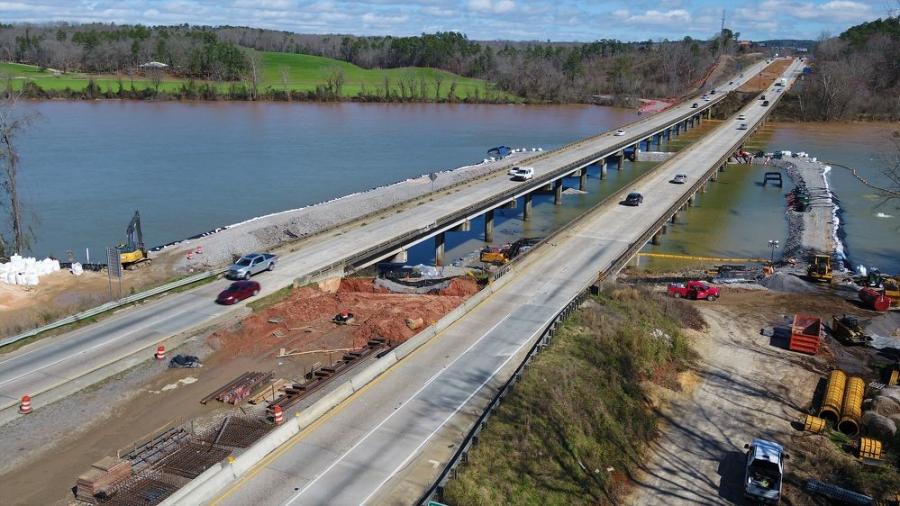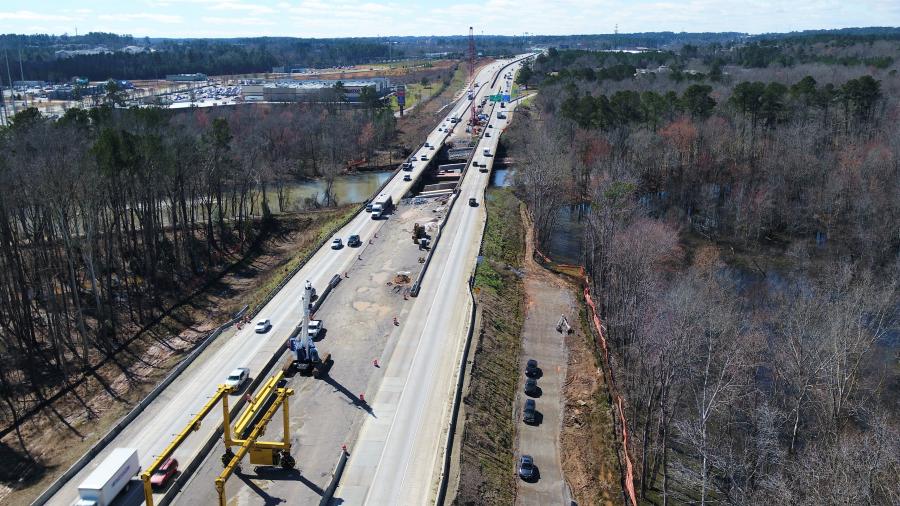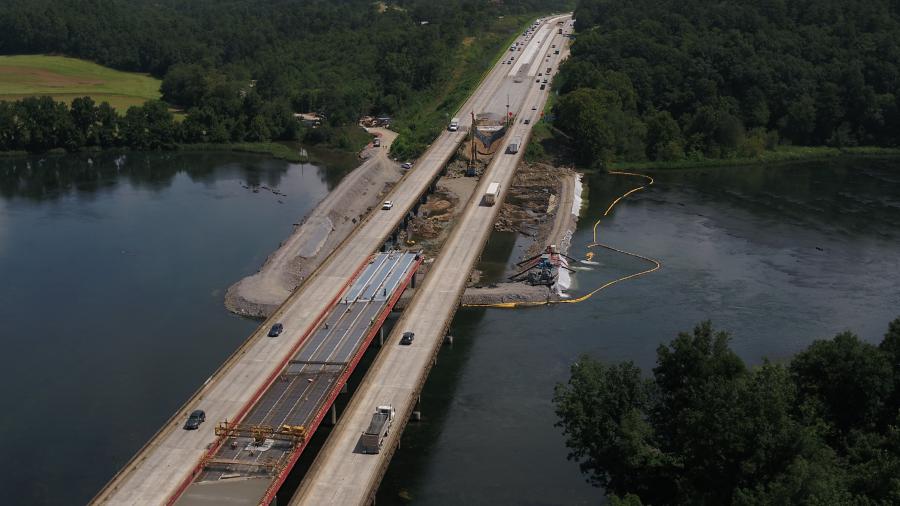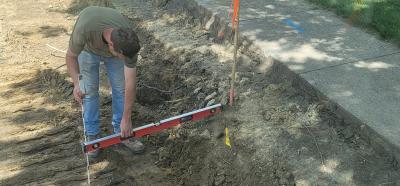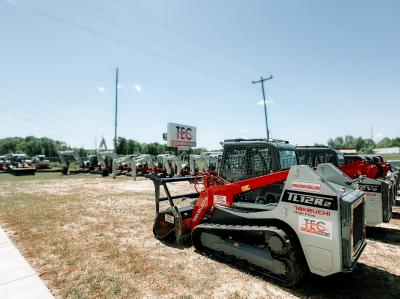This initiative is replacing and widening the existing I-20 bridges over the Augusta Canal and Savannah River within the city of Augusta, Ga. (Richmond County) and the city of North Augusta, S.C. (Aiken County) to improve safety and operations along I-20 that links the two states.
Superior Construction Co. Inc. expects to complete the $82.5 million I-20 @ Savannah River Bridge Replacements project for the Georgia Department of Georgia Transportation (GDOT) and the South Carolina Department of Transportation (SCDOT) in the winter of 2022.
This initiative is replacing and widening the existing I-20 bridges over the Augusta Canal and Savannah River within the city of Augusta, Ga. (Richmond County) and the city of North Augusta, S.C. (Aiken County) to improve safety and operations along I-20 that links the two states.
Construction began in January 2019 and the progress has been solid.
The project also will widen 1.8 mi. of I-20, replacing four bridges over the Augusta Canal and Savannah River, and is making intersection improvements at the West Martintown Road Interchange in South Carolina, including signalizing the intersection at Exit 1, placing a new signal at the I-20 EB off-ramp and West Martintown Road and turn lane improvements.
Construction Progress
Thus far, Superior Construction has completed the following: poured 1,779.9 cu. yds. of bridge deck concrete, set 1,268 linear ft. of 74-in. PSC beams, set 1,263.2 linear ft. of 78-in. PSC beams, set 244 linear ft. of 3-in. PSC beams, installed 975,563.62 lbs. of reinforced steel, placed 25,455.5 tons of GAB and paved 17,550 linear ft. (3.3 mi.) of 12-in. PCCP.
The remaining work will focus on the demolition and reconstruction of the existing WB and EB travel lanes during Phase 3 and Phase 4 construction, which followed the first major traffic shift on the weekend of Nov. 20. During each of the upcoming phases, Superior will install the same or more of the above-mentioned quantities.
"Some of the challenges we've faced were the failure of the Aquadam system prior to switching to a rock cofferdam, subcontractor availability and readiness due to transportation constraints and a reduction in workforce, COVID-19, water level increases due to weather, and dam releases, and adverse weather events," said Tim Marsh Sr., Superior's project manager.
"Superior negated the effects on these challenges by bringing on additional resources and assisting subcontractors with labor and transportation. The progress of work has returned to an exemplary standard of execution and should continue to improve as the project progresses.
"The water level of the Savannah River continues to be an off and on challenge due to the necessity of the dams upstream to release water to maintain their operational abilities," he added. "This project consists of both day and night work depending on the scope of work required. Superior strives to create open communications between all team members. Communication between all firms have been good and is one of the reasons we've been able to proactive with challenge and risk mitigation."
Superior began the Phase 3 demolition of the WB travel lanes and bridges on Dec. 1 and the Phase 4 demolition of the EB travel lanes will begin on Oct. 1, 2022.
"We will construct the new bridges will new footers, columns and caps followed by new girders and concrete bridge deck," said Marsh. "The major challenges are the Savannah River water levels, adverse weather events, labor force availability and global supply chain and transportation efficiency. The work is progressing as planned and will improve as we navigate through the end of the pandemic."
Key equipment for the bridge construction includes 275 ton track cranes, 55-ton service cranes, forklifts and excavators.
Superior will reconstruct the roadway between the Canal Bridge and the Savannah River Bridge first, then the South Carolina roadway portion of the project, followed by the Georgia welcome center end of the project.
"The challenges include rain events and transportation availability," said Marsh. "The work is progressing on schedule and continues to improve as the project progresses. There will be new drainage structures installed under both Phase 3 and Phase 4."
For the roadwork, crews are using excavators, forklifts, steel drum rollers, motor graders and dozers.
When the project is completed, 20,493 tons of concrete, 1170 tons of steel and 75,650 tons of earth and rock will be excavated, demolished and replaced.
Peak days have approximately 80 Superior Construction and subcontractor employees on-site. The subcontractors include firms from both Georgia and South Carolina.
Project's Need
"The existing bridges are functionally and structurally obsolete with substandard shoulder widths," said Kyle Collins, a spokesperson of GDOT. "By widening from four lanes to six lanes the reconstructed bridges will be better suited to conduct current and future traffic volumes The project represents the first bi-state agreement between Georgia and South Carolina for a Design-Build project. These bridges carry over 67,000 daily vehicles with higher future projections. Increased capacity with the added lanes and shoulders will make commutes better and emergency response safer and easier. One collision can gridlock traffic for miles with the limited existing footprint."
The Augusta Canal Bridges — 410-ft. long and two lanes in each direction — were built in 1964 and will be replaced with bridges that have three lanes in each direction (12-ft. wide) with a 2-ft. inner shoulder and 12-ft. outer shoulder.
The Savannah River Bridges were built in 1965 and the new structures will have the same features, with the lengths going from 1,216 ft. to 1,278 ft.
The work is taking place close to the Augusta Canal and Industrial District National Historic Landmark, the Augusta Canal National Heritage Area and the Tow Path, both of which have experienced limited closures due to the work.
The bi-state agreement to replace the bridges was signed in 2016. The project did not require any right-of-way (ROW) acquisitions. GDOT has taken the lead on the project.
The existing bridges carry 67,150 (2017 counts) cars and trucks (15 percent) daily and the new ones, based on a 2042 design year, are built to handle 93,300 vehicles daily. WSP designed the new bridges.
The construction plan has the DOTs maintaining traffic on the existing bridges as the new structures are being built, with some off-peak lane closures.
"Both nighttime and daytime temporary single lane closures and shoulder closures can be expected along I-20 for the duration of the project," said Collins. "Traffic shifts can be expected later in the project.
Work on the West Martintown Road and the bridge replacements and Georgia roadway widening began in the winter of 2019, with the South Carolina roadway widening starting in early 2020. The West Martintown Road intersection work was completed in late 2020.
To prepare for the major construction, crews placed temporary barriers along the roadway, conducted clearing and grubbing operations along the R.O.W., and installed erosion control measures. CEG
Today's top stories



